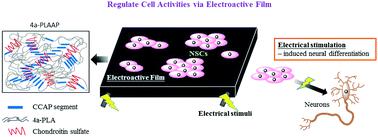当前位置:
X-MOL 学术
›
J. Mater. Chem. B
›
论文详情
Our official English website, www.x-mol.net, welcomes your feedback! (Note: you will need to create a separate account there.)
Biodegradable aniline-derived electroconductive film for the regulation of neural stem cell fate
Journal of Materials Chemistry B ( IF 7 ) Pub Date : 2020-12-23 , DOI: 10.1039/d0tb02171g Keui-Yu Chao, Wei-Yuan Huang, Chia-Yu Ho, Dehui Wan, Huan-Chih Wang, Chun-Yi Yang, Tzu-Wei Wang
Journal of Materials Chemistry B ( IF 7 ) Pub Date : 2020-12-23 , DOI: 10.1039/d0tb02171g Keui-Yu Chao, Wei-Yuan Huang, Chia-Yu Ho, Dehui Wan, Huan-Chih Wang, Chun-Yi Yang, Tzu-Wei Wang

|
Neural stem cells (NSCs) represent significant potential and promise in the treatment of neurodegenerative diseases and nerve injuries. An efficient methodology or platform that can help in specifically directing the stem cell fate is important and highly desirable for future clinical therapy. In this study, a biodegradable electrical conductive film composed of an oxidative polymerized carboxyl-capped aniline pentamer (CCAP) and ring-opening polymerized tetra poly(D,L-lactide) (4a-PLA) was designed with the addition of the dopant, namely chondroitin sulfate. This conductive film acts as a biological substrate for the exogenous/endogenous electric field transmission in tissue, resulting in the control of NSC fate, as well as improvement in neural tissue regeneration. The results show that CCAP is successfully synthesized and then conjugated onto 4a-PLA to form a network structure with electrical conductivity, cell adhesion capacity, and biodegradability. The neuronal differentiation of NSCs can be induced on 4a-PLAAP, and the neuronal maturation process can be facilitated by the manipulation of the electrical field. This biocompatible and electroactive material can serve as a platform to determine the cell fate of NSCs and be employed in neural regeneration. For future perspectives, its promising performance shows potential in applications, such as electrode-tissue integration interfaces, coatings on neuroprosthetics devices and neural probes, and smart drug delivery system in neurological systems.
中文翻译:

可生物降解的苯胺类导电膜,用于调节神经干细胞的命运
神经干细胞(NSC)在神经退行性疾病和神经损伤的治疗中具有巨大的潜力和希望。可以有效地指导干细胞命运的有效方法论或平台对于未来的临床治疗非常重要,也非常需要。在这项研究中,由氧化聚合的羧基封端的苯胺五聚体(CCAP)和开环聚合的四聚(D,L)组成的可生物降解的导电膜-丙交酯)(4a-PLA)的设计中加入了掺杂剂,即硫酸软骨素。该导电膜充当组织中外源/内源电场传输的生物基质,从而控制了NSC的命运,并改善了神经组织的再生。结果表明,成功地合成了CCAP,然后将其偶联到4a-PLA上,形成了具有导电性,细胞粘附能力和生物降解性的网络结构。NSC的神经元分化可以在4a-PLAAP上诱导,并且通过电场的操纵可以促进神经元成熟过程。这种生物相容性和电活性材料可以用作确定NSCs细胞命运的平台,并用于神经再生。对于未来的观点,
更新日期:2021-01-14
中文翻译:

可生物降解的苯胺类导电膜,用于调节神经干细胞的命运
神经干细胞(NSC)在神经退行性疾病和神经损伤的治疗中具有巨大的潜力和希望。可以有效地指导干细胞命运的有效方法论或平台对于未来的临床治疗非常重要,也非常需要。在这项研究中,由氧化聚合的羧基封端的苯胺五聚体(CCAP)和开环聚合的四聚(D,L)组成的可生物降解的导电膜-丙交酯)(4a-PLA)的设计中加入了掺杂剂,即硫酸软骨素。该导电膜充当组织中外源/内源电场传输的生物基质,从而控制了NSC的命运,并改善了神经组织的再生。结果表明,成功地合成了CCAP,然后将其偶联到4a-PLA上,形成了具有导电性,细胞粘附能力和生物降解性的网络结构。NSC的神经元分化可以在4a-PLAAP上诱导,并且通过电场的操纵可以促进神经元成熟过程。这种生物相容性和电活性材料可以用作确定NSCs细胞命运的平台,并用于神经再生。对于未来的观点,



























 京公网安备 11010802027423号
京公网安备 11010802027423号